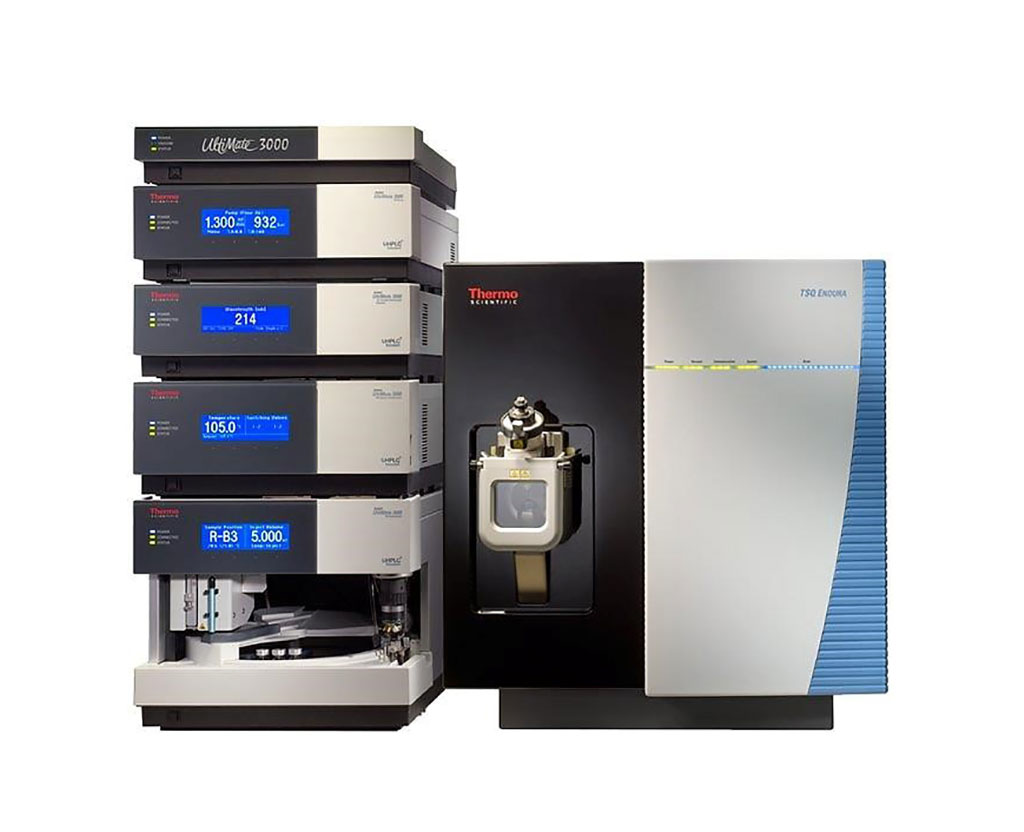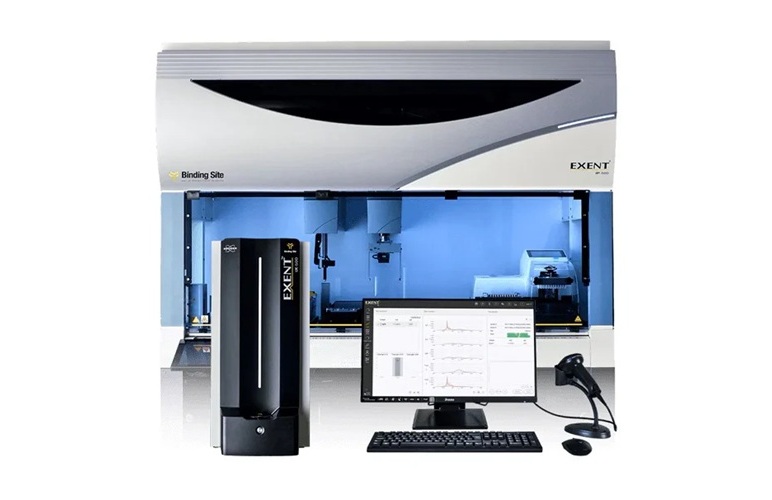Plasma Eicosanoids Characterized During Gestation Predicts Outcome
|
By LabMedica International staff writers Posted on 03 Sep 2020 |

Image: The UltiMate 3000 RS HPLC system and mass spectrometer (Photo courtesy of Thermo Fisher Scientific).
Fetal growth disorders are major risk factors for adverse pregnancy and later life outcomes. Proxy outcomes for disorders of fetal growth include small for gestational age (SGA) and large for gestational age (LGA) birth weight. Risk factors for SGA include maternal obstetrical complications, fetal genetic factors, infection, and various medical conditions.
Eicosanoids, an important class of lipid mediators derived from polyunsaturated fatty acids, can act as both direct influences and biomarkers of inflammation through a variety of biological pathways. Eicosanoids produced from the oxygenation of polyunsaturated fatty acid precursors, including the primary omega-6 fatty acids (linoleic acid [LA] and arachidonic acid [AA]) and omega-3 fatty acids (docosahexaenoic acid [DHA] and eicosapentaenoic acid.
Scientists from the National Institute of Environmental Health Sciences (Research Triangle, NC, USA) and their colleagues carried out a case–control study of 90 pregnant women within a cohort study that included 31 women who delivered small for gestational age (SGA) babies (SGA, ≤10th percentile), 28 who delivered large for gestational age (LGA) babies (≥90th percentile), and 31 who delivered appropriate for gestational age (AGA) babies (controls, >10th to <90th percentile).
A panel of eicosanoids and fatty acids was measured in plasma samples by the mass spectrometry. Non-esterified (free) eicosanoid and fatty acid levels were quantified by liquid chromatography with tandem mass spectrometry (LC-MS/MS). Online liquid chromatography and electrospray ionization tandem mass spectrometry of extracted plasma samples were performed on an UltiMate 3000 RS HPLC system and Quantiva mass spectrometer (Thermo Fisher Scientific, Waltham, MA, USA). For statistical analyses, they examined eicosanoids that were detected in ≥50% of all plasma samples analyzed. A total of 27 eicosanoids met this criterion while the other 30 were excluded.
The scientists reported that maternal plasma levels of eicosanoids and fatty acids generally followed U-shaped curve patterns across gestation. Bayesian models showed that associations between eicosanoids and case status varied by biosynthetic pathway. Eicosanoids derived from AA via the cytochrome P450 (CYP) and lipoxygenase (LOX) biosynthetic pathways were positively associated with SGA. The adjusted mean concentration of 12-Hydroxyeicosatetraenoic acid (12-HETE), a LOX pathway product, was 56.2% higher among SGA cases compared to AGA controls. Eicosanoid associations with LGA were mostly null, but negative associations were observed with eicosanoids derived from AA by LOX enzymes. The fatty acid precursors had estimated mean concentrations 41%–97% higher among SGA cases and 33%–39% lower among LGA cases compared to controls.
The authors concluded that eicosanoids and fatty acids systematically change in maternal plasma over pregnancy. Eicosanoids from specific inflammation-related pathways were higher in mothers of SGA cases and mostly similar in mothers of LGA cases compared to controls. These findings can provide deeper insight into etiologic mechanisms of abnormal fetal growth outcomes. The study was published on August 14, 2020 in the journal PLOS Medicine.
Eicosanoids, an important class of lipid mediators derived from polyunsaturated fatty acids, can act as both direct influences and biomarkers of inflammation through a variety of biological pathways. Eicosanoids produced from the oxygenation of polyunsaturated fatty acid precursors, including the primary omega-6 fatty acids (linoleic acid [LA] and arachidonic acid [AA]) and omega-3 fatty acids (docosahexaenoic acid [DHA] and eicosapentaenoic acid.
Scientists from the National Institute of Environmental Health Sciences (Research Triangle, NC, USA) and their colleagues carried out a case–control study of 90 pregnant women within a cohort study that included 31 women who delivered small for gestational age (SGA) babies (SGA, ≤10th percentile), 28 who delivered large for gestational age (LGA) babies (≥90th percentile), and 31 who delivered appropriate for gestational age (AGA) babies (controls, >10th to <90th percentile).
A panel of eicosanoids and fatty acids was measured in plasma samples by the mass spectrometry. Non-esterified (free) eicosanoid and fatty acid levels were quantified by liquid chromatography with tandem mass spectrometry (LC-MS/MS). Online liquid chromatography and electrospray ionization tandem mass spectrometry of extracted plasma samples were performed on an UltiMate 3000 RS HPLC system and Quantiva mass spectrometer (Thermo Fisher Scientific, Waltham, MA, USA). For statistical analyses, they examined eicosanoids that were detected in ≥50% of all plasma samples analyzed. A total of 27 eicosanoids met this criterion while the other 30 were excluded.
The scientists reported that maternal plasma levels of eicosanoids and fatty acids generally followed U-shaped curve patterns across gestation. Bayesian models showed that associations between eicosanoids and case status varied by biosynthetic pathway. Eicosanoids derived from AA via the cytochrome P450 (CYP) and lipoxygenase (LOX) biosynthetic pathways were positively associated with SGA. The adjusted mean concentration of 12-Hydroxyeicosatetraenoic acid (12-HETE), a LOX pathway product, was 56.2% higher among SGA cases compared to AGA controls. Eicosanoid associations with LGA were mostly null, but negative associations were observed with eicosanoids derived from AA by LOX enzymes. The fatty acid precursors had estimated mean concentrations 41%–97% higher among SGA cases and 33%–39% lower among LGA cases compared to controls.
The authors concluded that eicosanoids and fatty acids systematically change in maternal plasma over pregnancy. Eicosanoids from specific inflammation-related pathways were higher in mothers of SGA cases and mostly similar in mothers of LGA cases compared to controls. These findings can provide deeper insight into etiologic mechanisms of abnormal fetal growth outcomes. The study was published on August 14, 2020 in the journal PLOS Medicine.
Latest Clinical Chem. News
- Chemical Imaging Probe Could Track and Treat Prostate Cancer
- Mismatch Between Two Common Kidney Function Tests Indicates Serious Health Problems
- VOCs Show Promise for Early Multi-Cancer Detection
- Portable Raman Spectroscopy Offers Cost-Effective Kidney Disease Diagnosis at POC
- Gold Nanoparticles to Improve Accuracy of Ovarian Cancer Diagnosis
- Simultaneous Cell Isolation Technology Improves Cancer Diagnostic Accuracy
- Simple Non-Invasive Hair-Based Test Could Speed ALS Diagnosis
- Paper Strip Saliva Test Detects Elevated Uric Acid Levels Without Blood Draws
- Prostate Cancer Markers Based on Chemical Make-Up of Calcifications to Speed Up Detection
- Breath Test Could Help Detect Blood Cancers
- ML-Powered Gas Sensors to Detect Pathogens and AMR at POC
- Saliva-Based Cancer Detection Technology Eliminates Need for Complex Sample Preparation
- Skin Swabs Could Detect Parkinson’s Years Before Symptoms Appear
- New Clinical Chemistry Analyzer Designed to Meet Growing Demands of Modern Labs

- New Reference Measurement Procedure Standardizes Nucleic Acid Amplification Test Results
- Pen-Like Tool Quickly and Non-Invasively Detects Opioids from Skin
Channels
Molecular Diagnostics
view channel
Blood Test to Help Low-Risk Gastric Cancer Patients Avoid Unnecessary Surgery
Accurately identifying lymph node metastasis in early-stage gastric cancer remains a major clinical challenge. CT imaging often misses up to half of lymph node–positive cases, leading clinicians to recommend... Read more
First-Of-Its-Kind Automated System Speeds Myeloma Diagnosis
More than 176,000 people are diagnosed with multiple myeloma worldwide each year, yet the current diagnostic pathway can be slow and uncertain, often relying on a highly subjective interpretation of test results.... Read moreHematology
view channel
Platelet Activity Blood Test in Middle Age Could Identify Early Alzheimer’s Risk
Early detection of Alzheimer’s disease remains one of the biggest unmet needs in neurology, particularly because the biological changes underlying the disorder begin decades before memory symptoms appear.... Read more
Microvesicles Measurement Could Detect Vascular Injury in Sickle Cell Disease Patients
Assessing disease severity in sickle cell disease (SCD) remains challenging, especially when trying to predict hemolysis, vascular injury, and risk of complications such as vaso-occlusive crises.... Read more
ADLM’s New Coagulation Testing Guidance to Improve Care for Patients on Blood Thinners
Direct oral anticoagulants (DOACs) are one of the most common types of blood thinners. Patients take them to prevent a host of complications that could arise from blood clotting, including stroke, deep... Read moreImmunology
view channel
Gene Signature Test Predicts Response to Key Breast Cancer Treatment
DK4/6 inhibitors paired with hormone therapy have become a cornerstone treatment for advanced HR+/HER2– breast cancer, slowing tumor growth by blocking key proteins that drive cell division.... Read more
Chip Captures Cancer Cells from Blood to Help Select Right Breast Cancer Treatment
Ductal carcinoma in situ (DCIS) accounts for about a quarter of all breast cancer cases and generally carries a good prognosis. This non-invasive form of the disease may or may not become life-threatening.... Read moreMicrobiology
view channel
Rapid Assay Identifies Bloodstream Infection Pathogens Directly from Patient Samples
Bloodstream infections in sepsis progress quickly and demand rapid, precise diagnosis. Current blood-culture methods often take one to five days to identify the pathogen, leaving clinicians to treat blindly... Read more
Blood-Based Molecular Signatures to Enable Rapid EPTB Diagnosis
Extrapulmonary tuberculosis (EPTB) remains difficult to diagnose and treat because it spreads beyond the lungs and lacks easily accessible biomarkers. Despite TB infecting 10 million people yearly, the... Read more
15-Minute Blood Test Diagnoses Life-Threatening Infections in Children
Distinguishing minor childhood illnesses from potentially life-threatening infections such as sepsis or meningitis remains a major challenge in emergency care. Traditional tests can take hours, leaving... Read more
High-Throughput Enteric Panels Detect Multiple GI Bacterial Infections from Single Stool Swab Sample
Gastrointestinal (GI) infections are among the most common causes of illness worldwide, leading to over 1.7 million deaths annually and placing a heavy burden on healthcare systems. Conventional diagnostic... Read morePathology
view channelAI Tool Outperforms Doctors in Spotting Blood Cell Abnormalities
Diagnosing blood disorders depends on recognizing subtle abnormalities in cell size, shape, and structure, yet this process is slow, subjective, and requires years of expert training. Even specialists... Read more
AI Tool Rapidly Analyzes Complex Cancer Images for Personalized Treatment
Complex digital biopsy images that typically take an expert pathologist up to 20 minutes to assess can now be analyzed in about one minute using a new artificial intelligence (AI) tool. The technology... Read moreTechnology
view channel
AI Saliva Sensor Enables Early Detection of Head and Neck Cancer
Early detection of head and neck cancer remains difficult because the disease produces few or no symptoms in its earliest stages, and lesions often lie deep within the head or neck, where biopsy or endoscopy... Read more
AI-Powered Biosensor Technology to Enable Breath Test for Lung Cancer Detection
Detecting lung cancer early remains one of the biggest challenges in oncology, largely because current tools are invasive, expensive, or unable to identify the disease in its earliest phases.... Read moreIndustry
view channel
Abbott Acquires Cancer-Screening Company Exact Sciences
Abbott (Abbott Park, IL, USA) has entered into a definitive agreement to acquire Exact Sciences (Madison, WI, USA), enabling it to enter and lead in fast-growing cancer diagnostics segments.... Read more






















